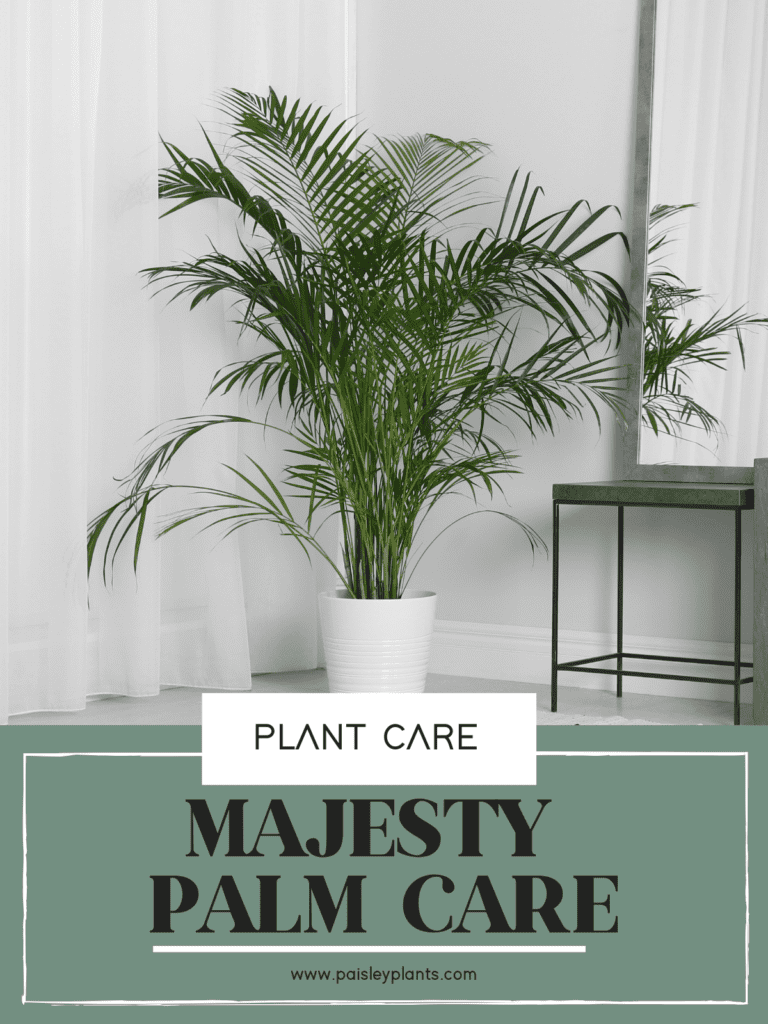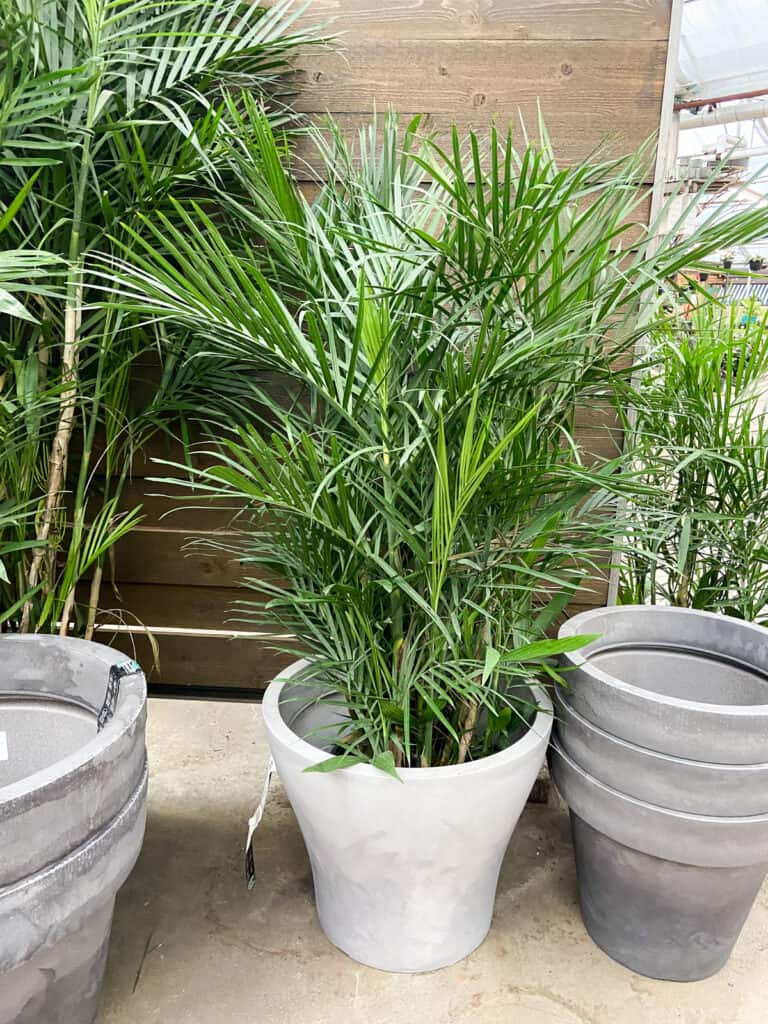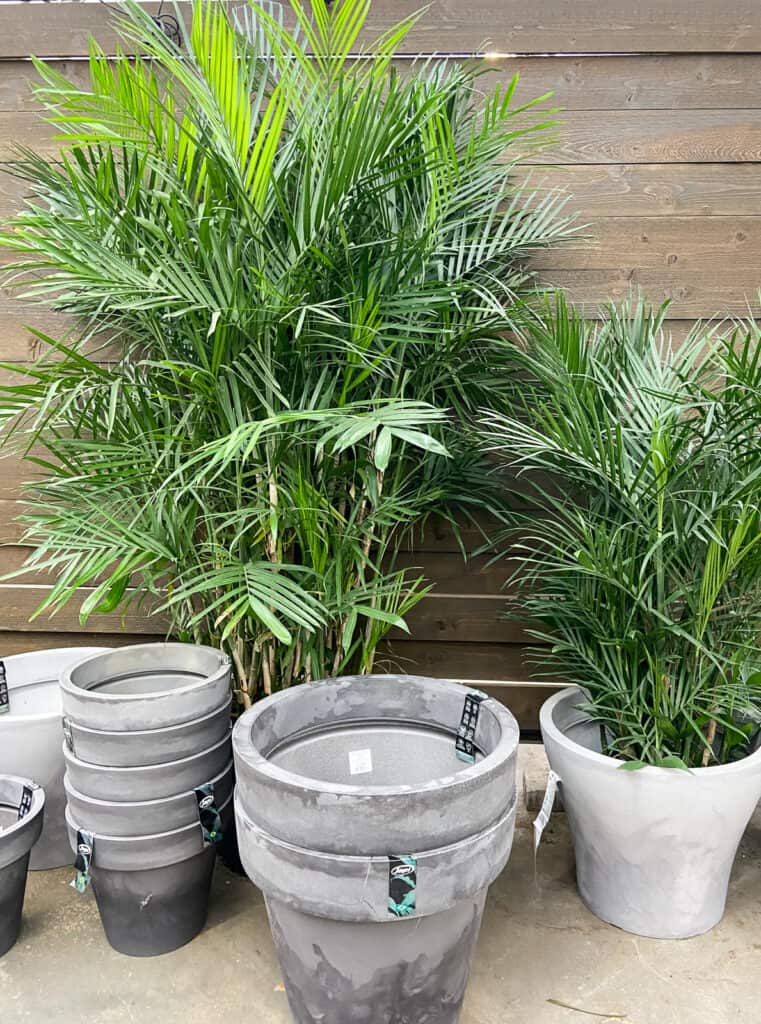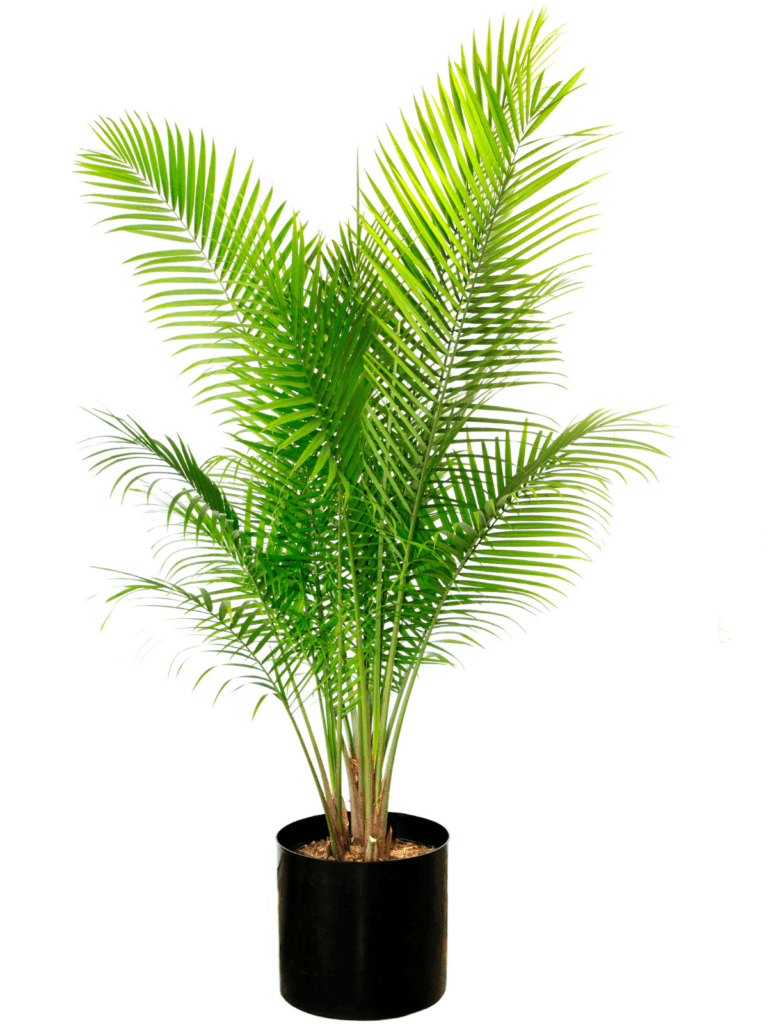Tall, elegant, and tropical, the majesty palm houseplant is an amazing addition to your houseplant collection. This is a great choice if you’re looking to challenge yourself with a houseplant that requires attentive care.
Read on for more information about the majesty palm and how to successfully raise it with this ultimate care guide.

Table of Contents
Background
Native to the tropical region of Madagascar, the majesty palm (Ravenea rivularis) is an extremely popular houseplant that helps bring the tropics into your home.
While the palm is often kept as an indoor houseplant, they can grown outdoors in areas that are able to sustain their temperature requirements.
These plants are hardy to USDA zones 10 & 11, therefore in areas such as southern California and Florida, you’re likely to see outdoor palms grown in home landscapes.
Majesty palms are considered to be slow-growing plants, only growing one foot per year until it reaches six tall, then it significantly slows down growth. At full maturity, your palm may get to be 10 feet tall, though this is only possible with extremely thorough care.
The majesty palm plant is non-toxic to pets and humans, so you can feel safe keeping this plant in your home with little ones nearby.
Majesty Palm Care

Sun & Light
It is best to provide your palm plant with as much bright, indirect light as possible; about 6 to 8 hours a day will be great for your plant’s health. However, I recommend that you try to avoid direct light, as this can cause burnt, crispy foliage.
Soil Type
They enjoy an acidic, well-draining soil that can still retain moisture. The ideal pH range for a palm’s soil is between 6.0 to 5.0. You can increase the natural acidity of your soil by amending a standard potting soil with peat moss.
Water
Your soil should be evenly moist, so regular waterings are necessary to keep your soil hydrated. At the same time, it is equally as important to avoid overwatering your plant’s soil; overwatering can lead to fungus and bacterial infections that are deadly to your palm.

Fertilizer
Your palm will greatly benefit from a diluted liquid fertilizer to help encourage strong growth. Apply this fertilize once or twice during the active growing season (spring & summer).
You may find that your palm’s leaves have begun to yellow. If this occurs, apply epsom salt to the soil once a month to give your palm a healthy dose of magnesium.
Temperature & Humidity
While the palm does prefer hot, humid weather, they are more than tolerable of normal household conditions. Try and aim for a temperature range between 65° and 85° F. If your home tends to be on the drier side, introducing a humidifier is an excellent way to reach a comfortable level of humidity for your plant. Please keep in mind that low humidity can make your plant more susceptible to pests.
Pruning & Maintenance
The palm will not require much pruning and maintenance. The only necessary maintenance that you will need to do is removing any dead or damaged foliage from your palm.
Choosing a Container & Repotting
You’ll likely find yourself having to repot your palm every other year, as these plants are relatively slow-growing. I highly recommend potting your majesty palm in a heavy container, as the foliage can cause this plant to become top-heavy.
Repotting your palm is also an excellent opportunity to try propagating your majesty plant by separating the small offshoots from the mother plant. Read on in your next section for a detailed guide on propagating.
How to Propagate a Majesty Palm
Finding majesty palm seeds are nearly impossible, and it is incapable of being propagated via leaf or stem cuttings. So how are these plants often propagated by their owners? They produce small “pups,” or offshoots that grow from the base of the main plant. These offshoots are removed and planted separately; they will eventually grow into fully-mature plants.
Follow these steps to remove the offshoots from your palm and propagate them.
- Gently remove the plant from its container.
- Inspect the base of your plant for any small offshoots; you may have to gently massage the root ball to loosen up the offshoots.
- Use a sharp, sterilized knife in order to remove the offshoot from the mother plant.
- Repot your offshoots in a separate container than is filled with well-draining soil.
- Water your offshoots deeply, making sure that the excess water drains out from the bottom of the planter.
- Place the offshoots in a similar location to the mother plant with bright, indirect lighting. In one month, fertilize the growing offshoots.
Common Pests

Majesty palms are susceptible to a number of common household pests, including aphids, whiteflies, mealybugs, and scale. Most of these pests can be avoided by maintaining proper humidity levels. While all of these pests are very unwelcome, they can be easily dealt with by using natural solutions.
My personal favorite pesticide is using neem oil to control the presence of insects. Wiping your plant’s foliage with neem oil or spraying it onto the soil are both very effective in curtailing pests. Whiteflies can be easy caught by laying down yellow sticky tape around your plant. Mealybugs can be deterred by rubbing the affected foliage with isopropyl alcohol.
Common Diseases
Like with many houseplants, the majesty palm is particularly susceptible to root rot. Root rot is caused by improper watering techniques, which results from plant owners who overwater their plants. This overwatering causes excess moisture to become trapped in the soil, which eventually breaks down the roots of the plant.
Root rot is very deadly, but very treatable when caught early. Early signs of root rot include dying, wilting, yellow foliage. If you suspect your plant is victim to root rot, gently remove the plant from its container and prune any rotted roots you may find. Rotted roots are mushy in texture and black/brown in color. Repot your palm with a sterilized pot and fresh, dry potting mix. Keep your soil lightly moist, but do be careful not to overwater, otherwise you’ll be back to square one!
FAQ
How big do majesty palms get?
When grown indoors, majesty palms can reach a mature height of 10′ high. While 10 ft is an awfully tall height, it’s nothing compared to how large majesty palm plants can reach in their natural habitat.
In the wild, it can reach a staggering height of up to 100′ tall. Unfortunately, they are an increasingly rare sight in the wild, so you’d have to be very lucky to stumble upon one of that size.
Is a majesty palm plant a good plant?
The majesty palm has a reputation of being a challenging indoor plant to care for. This is due to their lofty temperature, fertilizer, and humidity requirements. However, intermediate houseplant owners might enjoy the challenge of owning these plants, making this an excellent addition to the household.
I would not recommend this to houseplant newcomers, or gardeners with a busy schedule who don’t always have the time to monitor their plant’s well-being. The majesty plant is better left to owners who are able to dedicate more time to ensuring their palm’s needs are met.
Why are my majesty palm’s leaves turning yellow?
This can be a number of reasons! Here are some of the most common reasons for yellowing foliage:
- Overwatering/under-watering
- Lack of light
- Lack of humidity
- Nutrient deficiency
It can seem overwhelming trying to pinpoint why your majesty palm is turning colors, especially with so many possible causes. I would highly recommend going down the list of probable causes and see if making slight adjustments to your plant’s care regimen makes a difference.
Where to Buy
While the majesty plant may have a reputation for being a difficult plant, that’s no reason to shy away from owning one of these delightful tropical plants. As long as you give them the right amount of love and care, then you’ll be able to enjoy a happy, long life with your majesty palm.
Want more palm fun? Check out the Parlor Palm as well as the Chinese Fan Palm!

